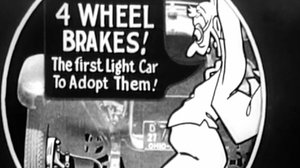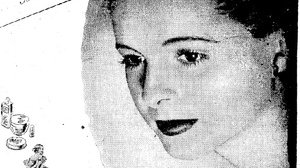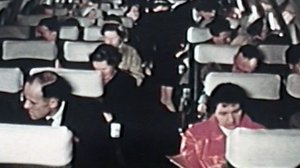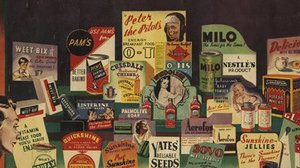Advertisements have catalysed creativity amongst New Zealand creative agencies, film and radio makers. On the arrival of television advertising in New Zealand, John O’Shea (of Pacific Films) observed:
"Commercials are in many ways technically more exacting, if not artistically more demanding [than full-length films]. The TV commercial is an expensive short film calling for a great deal of precision. It will use a variety of artists and all sorts of fancy optical work – wipes and dissolves, and superimposed shots, all the tricks of the trade […] It’s hard to do much entertaining in seven, ten, or even twenty seconds, yet they unroll before you with a fascinating directness, which combined with their brevity, somehow prevents boredom."
– "Television – With Commercials," NZ Listener, 24 Mar 1961
Many artists best known for their work outside the advertising medium – John Batten, Dick Frizzell, Roger Donaldson, Lee Tamahori, Vincent Ward, and others – have embraced the possibilities for innovation inherent in this short form.
Early Years
In Promoting Prosperity: The Art of Early New Zealand Advertising Brian Sweeney argues that New Zealand advertising goes back as far as the 1840s, when Edward Gibbon Wakefield commissioned idealised painted images to promote settlement in this country. In the audiovisual sphere, advertising is almost as old as the medium. From the early twentieth century cinema owners were provided with instructions on how to make their own static advertisements on glass slides.
By the 1920s moving image advertisements were being made professionally by production companies and circulated to cinemas to screen before the featured programming. The 1920s advertisements showcased in this collection creatively combine live action footage with camera trickery and basic animation to highlight the virtues of the products being advertised.
Radio Advertising
Radio was first broadcast in New Zealand in 1921. Initially advertising was banned, with the government resisting the "American model" of commercial broadcasting, in favour of the BBC-style, non-commercial option. Some early private stations did have commercial "sponsors," but it wasn’t until the first Labour government nationalised radio broadcasting and created the National Commercial Broadcasting Service (NCBS) in 1936, that the first radio advertisements – in the modern sense – hit the airwaves.
The Prime Minister of the day, Michael Joseph Savage, was in favour of radio advertising as it supplemented funding and diversified programming for radio (previously stations had relied on income from the sale of licences to own radio players to survive). Initially there were four commercial radio stations – 1ZB Auckland, 2ZB Wellington, 3ZB Christchurch and 4ZB Dunedin – in the world's first state-owned commercial broadcasting service.
Radio was an opportune medium for advertising due to its rapid growth and ability to reach into homes and connect with families via soundwaves. By 1938, the NCBS estimated "there are some 1,140,028 listeners in the New Zealand radio family" – for a national population of 1,601,758. The NCBS appealed to prospective advertisers:
"The businessman who wishes to make a community appeal should not neglect radio. It has the advantage of personally delivering a message – and the importance of this cannot be over-estimated. The voice can demand rapt attention. Into it can be injected the personality of the speaker. The emotions can be appealed to – and are not many people more easily influenced emotionally than intellectually? The radio is a breathing, living thing, it is warm and pulsating, it goes right into our hearts."
– "New Zealand Radio Advertising" magazine, NCBS, 1938
In the early years of radio advertising, a typical strategy was for a company to sponsor a regular radio programme. Announcer-presented product endorsements were also common. Soon other forms of advertising, such as public service promotions, jingles, and multi-character skits, began to emerge. Radio stations developed their own advertising departments, with creative copywriters and commercial producers who specialised in ear-catching copy and jingles. External advertising agencies would create radio commercials also.
The introduction of television in the 1960s brought in competition for advertising spend. In response to this, radio stations began to target specific demographics. Radio offered more opportunities for targeting people based on location, for example, than TV – which was national in focus. As more private stations began to emerge, led by the Radio Hauraki "pirates" in 1966, radio was able to diversify its programming and advertising to reflect factors such as listeners’ age, gender, ethnicity, social status and lifestyle. Today, talk radio, golden oldies, iwi, new migrants, and every different genre of music have their own station and advertisers.
Television Advertising
Television was introduced to New Zealand in 1960, until the end of the 1980s there was just one publicly-owned network. Commercial television was adopted on 1 April 1961, based on precedents overseas. Initially, TV advertising was only available in Auckland, the commercial slots were: Tues 6.30 - 10.30pm, Wed 8 - 10.30pm, Thurs 6.30 - 10.30pm and Sat 6.30 - 10.30pm. During these windows six minutes of the hour were dedicated to advertising.
Creative agencies (who managed the concept and liaison with the client placing the advertisement) and production companies (who oversaw the filmmaking elements) collaborated to produce inventive advertising work. Production companies whose work features prominently in this exhibition include: Peach Wemyss Astor, Morrow Productions, Pacific Films, Birch Rising Productions, Aardvark Films, Silver Screen Productions and Flying Fish. Agencies include: Charles Haines, ColensoBBDO , and Saatchi & Saatchi. Artist Dick Frizzell, who started his career at an advertising agency during the 1960s, recalls:
"It was all very democratic and anyone could throw in their two bob’s worth at any point [ …] No computers. Technicians fiddling for hours trying to tee it all up… but, oh the triumph when it all kicked in… Sibelius booming out over the grand panorama. Between us and the Production Houses we figured these things out. Invariably with Kiwi solutions that I suspect bore no resemblance to the original technology."
– Dick Frizzell, "Promoting Prosperity" (Craig Potton Publishing, 2013)
Colour television was introduced in 1973, further enhancing the creative possibilities of advertising. According to Television New Zealand, by 1983 the total number of television licences in the country was 925,306. 768,650 of these were colour TV sets. This same year, TVNZ described TV as:
"the ultimate weapon in marketing […] It offers movement which makes it a perfect demonstration medium […] It combines sound and vision to become the personal medium, displaying emotions and people with a reality that a voice alone on radio cannot achieve"
– "Television and Advertising Effectiveness," TVNZ flyer, 1983
In spite of the perceived competition between television and other advertising mediums, advertisers did use TV, radio and newspaper in complementary ways. The repetition of jingles and taglines across the differing forms was a common strategy for achieving greater brand recognition. For example, the "are your Macleans showing?" jingle was recurrent across this company’s radio and television advertising over several decades.
In 1989 the emergence of TV3, which was privately owned, followed by the subscription-based Sky network in 1990, resulted in increased competition for advertising spend. By the early 2010s, television was completely digital. The new digital technologies made it simple for viewers to skip the ads, encouraging advertisers to move away from traditional models of TV advertising and towards dispersed new forms of web, digital and multi-media advertising.
Does Advertising Reflect Us?
Advertising reflects facets of the way we were – the way we spoke, the music we listened to, our familial roles, changing attitudes towards health and sexuality... However, it must be noted that these images of life are refracted through the lenses of the dominant culture and consumerist ideologies. Several studies have noted glaring issues of representation in advertising, which mean we should use our critical faculties when consuming them. As recently as 2013 (Rubie-Davies, Liu and Lee), research has revealed an overwhelming predominance of Pākeha characters; and, conversely, an unacceptable under-representation of Māori, Pasifika and Asian characters; in television advertising. Also, women remain under-represented in professional roles and over-represented in maternal, homemaking and aesthetic roles (see Carolyn, 2012). Nonetheless, the efforts and creativity of people working in the advertising medium to change traditional representational stereotypes – in campaigns such as Gregg's "Different Faces," the National Bank "Henry" series, the te reo Rinso jingle, and the "Our Children, Our Future, Our Millennium" ad – should be applauded.
References
- Alsop, Peter and Gary Stewart. Promoting Prosperity: The Art of Early New Zealand Advertising. Craig Potton Publishing: Nelson, 2013.
- ANZA - Association of New Zealand Advertisers. "Advertising Today: Questions & Comments about Advertising," flier, 1972.
- Downes, Peter and Peter Harcourt. Voices in the Air – Radio Broadcasting in New Zealand. Radio New Zealand: Methuen, 1976.
- Dunleavy, Trisha. "Story: Television," Te Ara, 2014.
- Furnham, Adrian and Elena Farragher. "A Cross-Cultural Content Analysis of Sex-Role Stereotyping in Television Advertisements: A Comparison Between Great Britain and New Zealand." Journal of Broadcasting & Electronic Media, 1 September 2000, Vol. 44 (3), 415-436.
- Michelle, Carolyn. "Co-Constructions of Gender and Ethnicity in New Zealand Television Advertising." Sex Roles, 2012, Vol. 66 (1), 21-37.
- Rubie-Davies, Christine, Sabrina Liu and Kai-Chi Katie Lee. "Watching Each Other: Portrayals of Gender and Ethnicity in Television Advertisements." The Journal of Social Psychology, 2013, Vol. 153 (2), 175-95.
- New Zealand Radio Advertising, magazine. National Commercial Broadcasting Service, 1938.
- Television and Advertising Effectiveness, flyer. Television New Zealand. 1983.







